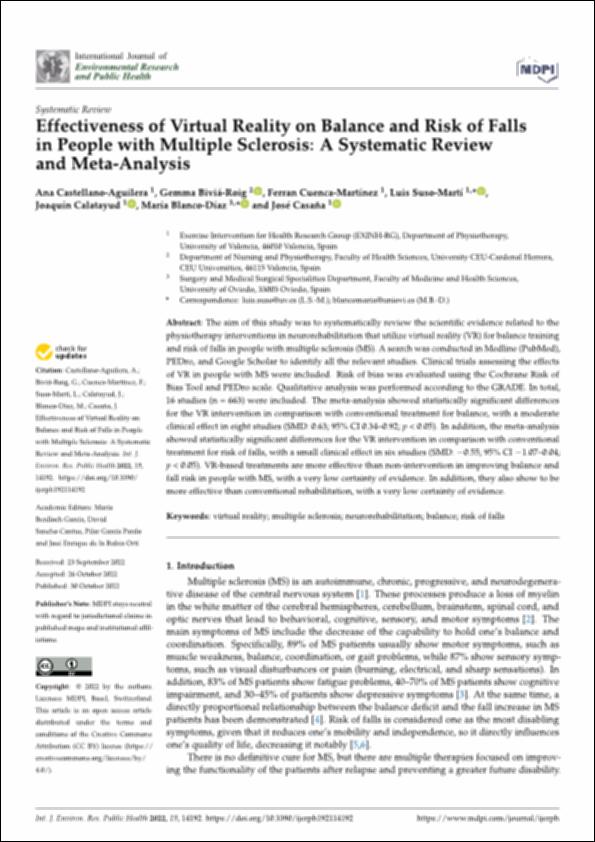Please use this identifier to cite or link to this item:
http://hdl.handle.net/10637/14223Effectiveness of virtual reality on balance and risk of falls in people with multiple sclerosis a systematic review and meta-analysis
| Title: | Effectiveness of virtual reality on balance and risk of falls in people with multiple sclerosis a systematic review and meta-analysis |
| Authors : | Castellano Aguilera, Ana Biviá Roig, Gemma Cuenca Martínez, Ferran Suso Martí, Luis Calatayud Villalba, Joaquín Blanco Díaz, María Casaña Granell, José |
| Keywords: | Equilibrio - Trastornos - Fisioterapia.; Equilibrium disorders - Physical theraphy.; Multiple sclerosis - Treatment.; Realidad virtual - Aplicaciones en fisioterapia.; Esclerosis múltiple - Tratamiento.; Virtual reality in physical theraphy. |
| Publisher: | MDPI |
| Citation: | Castellano-Aguilera, A., Biviá-Roig, G., Cuenca-Martínez, F., Suso-Martí, L., Calatayud, J., Blanco-Díaz, M. & Casaña, J. (2022). Effectiveness of virtual reality on balance and risk of falls in people with multiple sclerosis: a systematic review and meta-analysis. International Journal of Environmental Research and Public Health, vol. 19, i. 21 (30 oct.), art. 14192. DOI: https://doi.org/10.3390/ijerph192114192 |
| Abstract: | The aim of this study was to systematically review the scientific evidence related to the physiotherapy interventions in neurorehabilitation that utilize virtual reality (VR) for balance training and risk of falls in people with multiple sclerosis (MS). A search was conducted in Medline (PubMed), PEDro, and Google Scholar to identify all the relevant studies. Clinical trials assessing the effects of VR in people with MS were included. Risk of bias was evaluated using the Cochrane Risk of Bias Tool and PEDro scale. Qualitative analysis was performed according to the GRADE. In total, 16 studies (n = 663) were included. The meta-analysis showed statistically significant differences for the VR intervention in comparison with conventional treatment for balance, with a moderate clinical effect in eight studies (SMD: 0.63; 95% CI 0.34–0.92; p < 0.05). In addition, the meta-analysis showed statistically significant differences for the VR intervention in comparison with conventional treatment for risk of falls, with a small clinical effect in six studies (SMD: 0.55; 95% CI 1.07–0.04; p < 0.05). VR-based treatments are more effective than non-intervention in improving balance and fall risk in people with MS, with a very low certainty of evidence. In addition, they also show to be more effective than conventional rehabilitation, with a very low certainty of evidence. |
| Description: | Este artículo se encuentra disponible en la siguiente URL: https://www.mdpi.com/1660-4601/19/21/14192 Este artículo de investigación pertenece al número especial "Promotion of Health Habits to Prevent and Treat Mental and Neurological Disorders". |
| URI: | http://hdl.handle.net/10637/14223 |
| Rights : | http://creativecommons.org/licenses/by/4.0/deed.es |
| ISSN: | 1660-4601 (Electrónico) |
| Language: | es |
| Issue Date: | 30-Oct-2022 |
| Center : | Universidad Cardenal Herrera-CEU |
| Appears in Collections: | Dpto. Enfermería y Fisioterapia |
Items in DSpace are protected by copyright, with all rights reserved, unless otherwise indicated.


